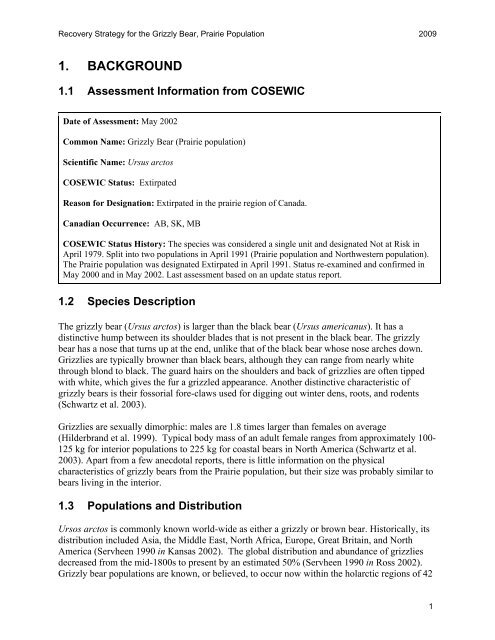Grizzly Bear (Ursus arctos), Prairie Population - Publications du ...
Grizzly Bear (Ursus arctos), Prairie Population - Publications du ...
Grizzly Bear (Ursus arctos), Prairie Population - Publications du ...
Create successful ePaper yourself
Turn your PDF publications into a flip-book with our unique Google optimized e-Paper software.
Recovery Strategy for the <strong>Grizzly</strong> <strong>Bear</strong>, <strong>Prairie</strong> <strong>Population</strong> 2009<br />
1. BACKGROUND<br />
1.1 Assessment Information from COSEWIC<br />
Date of Assessment: May 2002<br />
Common Name: <strong>Grizzly</strong> <strong>Bear</strong> (<strong>Prairie</strong> population)<br />
Scientific Name: <strong>Ursus</strong> <strong>arctos</strong><br />
COSEWIC Status: Extirpated<br />
Reason for Designation: Extirpated in the prairie region of Canada.<br />
Canadian Occurrence: AB, SK, MB<br />
COSEWIC Status History: The species was considered a single unit and designated Not at Risk in<br />
April 1979. Split into two populations in April 1991 (<strong>Prairie</strong> population and Northwestern population).<br />
The <strong>Prairie</strong> population was designated Extirpated in April 1991. Status re-examined and confirmed in<br />
May 2000 and in May 2002. Last assessment based on an update status report.<br />
1.2 Species Description<br />
The grizzly bear (<strong>Ursus</strong> <strong>arctos</strong>) is larger than the black bear (<strong>Ursus</strong> americanus). It has a<br />
distinctive hump between its shoulder blades that is not present in the black bear. The grizzly<br />
bear has a nose that turns up at the end, unlike that of the black bear whose nose arches down.<br />
Grizzlies are typically browner than black bears, although they can range from nearly white<br />
through blond to black. The guard hairs on the shoulders and back of grizzlies are often tipped<br />
with white, which gives the fur a grizzled appearance. Another distinctive characteristic of<br />
grizzly bears is their fossorial fore-claws used for digging out winter dens, roots, and rodents<br />
(Schwartz et al. 2003).<br />
Grizzlies are sexually dimorphic: males are 1.8 times larger than females on average<br />
(Hilderbrand et al. 1999). Typical body mass of an a<strong>du</strong>lt female ranges from approximately 100-<br />
125 kg for interior populations to 225 kg for coastal bears in North America (Schwartz et al.<br />
2003). Apart from a few anecdotal reports, there is little information on the physical<br />
characteristics of grizzly bears from the <strong>Prairie</strong> population, but their size was probably similar to<br />
bears living in the interior.<br />
1.3 <strong>Population</strong>s and Distribution<br />
Ursos <strong>arctos</strong> is commonly known world-wide as either a grizzly or brown bear. Historically, its<br />
distribution included Asia, the Middle East, North Africa, Europe, Great Britain, and North<br />
America (Servheen 1990 in Kansas 2002). The global distribution and abundance of grizzlies<br />
decreased from the mid-1800s to present by an estimated 50% (Servheen 1990 in Ross 2002).<br />
<strong>Grizzly</strong> bear populations are known, or believed, to occur now within the holarctic regions of 42<br />
1

















